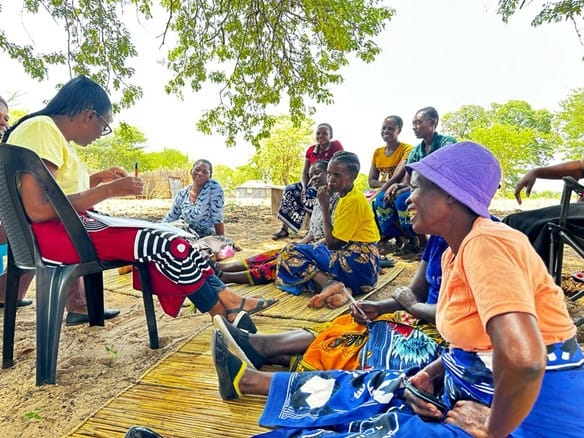By Giriraj Amarnath and Niranga Alahacoon

In response to escalating climate challenges, particularly prolonged droughts, community-level preparedness has become a necessity rather than an option. Sri Lanka, frequently affected by climate-induced droughts, reached a significant milestone with its first-ever Community-Level Anticipatory Action Simulation in the Anuradhapura district. This landmark event highlights the power of anticipatory action, integrating science-driven forecasts with localized response systems to safeguard lives, livelihoods, and ecosystems before disasters strike.
Why anticipatory action?
Anticipatory action emphasizes taking timely, informed decisions to prevent hazards from escalating into disasters. By acting early, based on credible forecasts, communities can:
- Preserve vital resources such as water, livestock, and food reserves.
- Minimize dependence on costly emergency responses.
- Strengthen long-term resilience through actionable knowledge and preparedness.
Unlike reactive approaches, anticipatory action shifts the focus from relief to resilience by bridging climate science, risk monitoring, and proactive interventions on the ground.
Collaborative and inclusive design
The simulation was co-developed with local communities, government agencies, technical experts, and development partners to address drought-specific vulnerabilities. Government institutions contributed expertise in agricultural and water management, while technical specialists provided forecast data and risk analysis. On-the-ground perspectives came from local leaders, including women’s groups and farmer networks, supported by development organizations facilitating the anticipatory frameworks.
This initiative went beyond testing preparedness mechanisms; it evaluated existing systems, identified strengths, and pinpointed areas requiring improvement, ensuring long-term adaptability and drought resilience for vulnerable communities.
The purpose of the Drought Anticipatory Action Simulation was to equip local communities with proactive strategies to mitigate drought impacts effectively. Conducted over two days (December 13-14, 2024) in the Ellawewa Grama Niladari Division of the Galenbindunuwewa Divisional Secretariat Division (DSD), Anuradhapura, the simulation targeted over 300 individuals from 106 families. Facilitated through a partnership between the International Water Management Institute (IWMI), and the Department of Agrarian Development (DAD) initiative enhanced awareness, preparedness, and resilience.

Simulation framework: the three phases of anticipatory action
- Preparedness Phase: Focused on early warning dissemination and community awareness:
- Delivered timely and accurate seasonal drought forecasts via SMS alerts in local languages to maximize comprehension.
- Cleaned and inspected existing water sources—wells, tanks, and natural springs—to ensure functionality.
- Repaired and reinforced deep-water wells for improved future use.
- Conducted workshops on water-saving techniques like rainwater harvesting, minimizing water wastage, and practical demonstrations.
- Trained communities in food preservation methods (e.g., drying, canning, freezing) to ensure food security during prolonged drought.
- Promoted stockpiling essential grains and perishables for household resilience.
- Readiness Phase: Strengthened resource mobilization and response mechanisms:
- Identified and restored traditional water storage systems while promoting sustainable water harvesting methods.
- Established livestock feeding grounds equipped with necessary infrastructure to support drought conditions.
- Secured alternative livestock feed, such as fodder crops, to maintain animal health and productivity.
- Positioned water bowsers strategically for quick and equitable water distribution during shortages.
- Trained farmers in adaptive agricultural techniques, including drought-resistant crops, early harvesting, and soil moisture conservation.
- Mobilized medical teams and organized health awareness programs to mitigate drought-related health risks.
- Activation Phase: Triggered by forecasts and indicators from IWMI’s AWARE Platform, supported by CGIAR initiatives on Climate Resilience and Japan’s Ministry of Agriculture, Forestry and Fisheries:
- Relocated livestock to pre-designated feeding areas while ensuring their health and monitoring conditions.
- Deployed water bowsers to provide potable water to vulnerable households experiencing severe shortages.
- Sent medical teams to assess and address health needs, prioritizing children, the elderly, and other at-risk groups.
A model for drought and flood prone regions
Sri Lanka’s pioneering anticipatory action simulation builds on successful approaches to disaster preparedness demonstrated globally. A similar initiative on flood and landslides in Sri Lanka and flood preparedness in Zambia, Senegal facilitated by IWMI and its partners under CGIAR Climate Resilience initiatives, showcased how early warning systems can empower communities to respond effectively to drought risks, saving lives and livelihoods. These efforts highlighted the value of accessible forecasts and well-planned local interventions for timely response and preparedness.
Sri Lanka’s simulation now sets a new benchmark for drought-prone regions. With increasing climate risks, forecast-based early actions can:
- Safeguard livelihoods by preserving critical resources such as water, food, and livestock;
- Reduce dependency on costly post-disaster humanitarian aid;
- Build lasting resilience through localized, proactive measures.
By integrating science-driven climate forecasts with community-led actions, this simulation significantly lowered risks, enhanced coordination, and strengthened response systems at the ground level. This landmark initiative demonstrates the transformative potential of anticipatory action when science, governance, and community-driven solutions align. By staying one step ahead of climate hazards, communities can better manage drought risks, reduce vulnerabilities, and secure sustainable futures.
We recognize the invaluable contributions of Sri Lanka’s communities, government institutions, and development partners in bringing this initiative to life.















